Transportation Cost
-
- The Tug And Barge Industry Provides A Wealth Of Benefits To American Consumers Maritime Reporter, Jun 1988 #44
The tug and barge industry plays a major role in the local economy, but unless you live or work along the banks of the nation's waterways, you might not realize what's happening when all those huge lumbering barges float by the shoreline, loaded with who-knows-what, bound for who-knows-where.
On a national scale the U.S. waterways industry carries more than 13 percent of all the nation's total goods, on rivers, canals, and intracoastal waterways of America, aboard thousands of gigantic silent barges of all shapes, sizes, and functions.
This is a nationwide fleet of 7,500 coastal tugboats, inland river towboats, and over 32,000 huge barges of all dimensions, which ply the waters of the Atlantic, Pacific, the Gulf Coasts, and work on rivers all over the country—the Mississippi, the Ohio, the Columbia, the Hudson, the Missouri, the Tennessee, and others. It is an industry which pulls and pushes vast quantities of material on over 125,000 domestic voyages each year, to and from over 200 U.S. inland and coastal ports.
Strangely, although huge in size, scope, reach, equipment and employment, the nation's tugboat and barge towing industry is little known for either its overall contribution to the American economy, or for the main factor that enables that contribution to be so significant—- the remarkable efficiency of these waterborne giants.
A towboat (which actually pushes) and its string of cargo-laden barges are not what one would usually think of as inflation fighters.
But they are. The key is cost. One of the great contributors to the escalating prices of basic consumer goods like food and energy is the factor of "Operating costs," and a big portion of those costs is transportation.
Since keeping transportation cost down is important to keeping consumer costs down, the call is for efficiency—the ability to move large quantities of material at low overhead cost in a competitive marketplace. And that's what we do.
In fact, such a description seems to define the tugboat and barge towing industry exactly.
The statistics on the barge industry's capacity are astonishing, at least. In fact, according to the American Waterways Operators (the barge industry's trade association), a single barge can transport the harvest of over 1,500 acres of farmland, or enough gasoline to drive your car over 9 million miles, or enough coal to light and heat your home for 700 years!
Transportation of materials on the inland and coastal waterways of the United States is geared to flexible, low-cost delivery of gigantic quantities of the essential raw materials, fuels, building materials, and other main components of American life. Last year, over 558 million tons of raw materials like grain, soybeans, and other agricultural products, petroleum, lumber, chemicals, steel, and coal traveled by barge along the inland and intracoastal waterways of the nation. Essentials like housing prices and electricity rates are directly affected by the cost of transporting the materials that comprise and power them, and a firm case can be mde that it is the tug and barge industry's efficiency that helps hold down the price for consumers.
This remarkable efficiency—this ability to move tremendous quantities of essential materials effectively and inexpensively—is the key that saves consumers money on everything from gasoline to home heating oil, from orange juice to electricity.
Such efficiency can be seen in the following example: on the lower Mississippi River, a single powerful towboat often pushes as many as 40 barges at one time. To move the same amount of material by railroad, it would require 600 rail cars.
Or, to move the same amount of material by truck would require more than 2,200 semi-trucks. This kind of transportation cost efficiency has a direct cost-benefit effect on the price of the most basic materials of American life.
There is another major factor in the cost-to-consumer equation: competition. The water carriers provide hefty competition to the United States' railroads for the movement of many important bulk freight materials, and the water carriers help hold down prices consumers pay because of the transportation alternative they provide. Many things that can be moved by rail, can also be moved by water, and the two forms of transportation vie in a healthy—but fiercely competitive— marketplace.
So the next time you see a string of barges moving quietly along a river or the coast, think about what it is doing for you. If it's carrying fertilizer, it is moving by the most inexpensive transport available, which means America's farmers can grow food cheaper. If it's carrying coal, no other form of transport brings fuel to utilities as cheaply and efficiently as barge transport—which means your electricity bill may not climb as steeply, and which means more discretionary buying power for you.
-
- New England Company Receives U.S. Funds To Investigate Giant Sphere As Offshore Oil Terminal Maritime Reporter, Nov 15, 1977 #46
much as 25 miles inland. In sum, the National Bureau of Standards says Tuned Spheres will (1) improve safety of vessels, hence personnel, (2) reduce transportation cost of oil, (3) reduce danger of oil spills, and (4) improve productivity during bad weather and sea condition. The report also concludes
-
- DOT Approves Two Offshore Superports For Large Tankers Maritime Reporter, Jan 15, 1977 #7
permit the country to respond to an energy crisis more efficiently. He also predicted that use of very large tankers would reduce the transportation cost of importing oil by up to 30 percent. One port, located 18 miles off Grand Isle, La., will be operated by Loop Inc. This firm is a consortium co
-
- WindShip Technology Promises Fuel Saving s Maritime Reporter, Mar 2000 #56
. The proposed WindShip was compared to conventional ships, and it was concluded that in spite of significant fuel savings an increased overall transportation cost of approx. 10 percent resulted. The work resulted in a report: "Modern WindShips — Phase 1," published at the end of 1996. Based on the
-
- ULCC: Hellespont Alhambra Proves Efficient Maritime Reporter, Mar 2003 #10
, but those who have used them have first hand knowledge that their speed, flexibility and economies of scale result in a lower dollar per barrel transportation cost." Hellespont Alhambra lifted more than 400.000 tons of crude ex Kharg Island and Juaymah on January 8, 2003, and delivered in Rotterdam
-
- WHERE'S THE PORK BARREL? Maritime Reporter, May 1985 #34
and waterways long enough to circle the earth. In addition we carry 13 percent of the nation's freight for just 2 percent of the national transportation cost, and we do it with the best safety record of any transportation industry. In a typical year, there will be 125,000 barge movements to and
-
- Come Together, Right Now … Marine News, Jun 2014 #22
inland waterways. The waterways are vital to our manufacturing sectors and to the construction industry. American consumers benefit from transportation cost-savings made possible by the inland waterways; for every $1 invested in our inland waterways, $10 is returned in national benefits. It is
-
- FMC Approves Filings by the New York Shipping Exchange Maritime Logistics Professional, Nov/Dec 2017 #10
in competition (b.) whether it is likely to produce an unreasonable reduction in transportation service, or (c.) an unreasonable increase in transportation cost. The answer is no to all questions; therefore I voted to allow the agreements to move forward. NYSHEX is an early entrant to the concept
-
- Containershipping: Restoring Balance Maritime Reporter, Mar 2019 #16
for container operators and increase visibility across the supply chain. The ultimate objective is to minimize the total relevant costs such as transportation cost, handling cost, and holding cost, while giving liner operators and managers greater control over their operations. It will make it much easier
-
- Navigating the Rough Waters of Misclassification Maritime Logistics Professional, May/Jun 2017 #17
Over the last few decades, international trade has exploded, driven in large part by tremendous improvements in efficiency and transportation cost reductions related to the containerization of freight. Reaping success depends on an intricately orchestrated chain of events where owner-operator independent
-
- Op/Ed: Making the Mississippi River Mightier Marine News, Nov 2017 #34
the allocations of the Harbor Maintenance Tax (HMT) to maintain the Ship Channel and to deepen the channel to 50 feet to maximize the reduced transportation costs to the American Farmers. The Recommended Plan documents a total investment cost of $191,124,016 while increasing the cost of the project
-
- The Environmental Wave: Successes And Challenges Maritime Reporter, Mar 1991 #24
area; thus far, the domestic and international marine insurance community will certify only federal requirements. Will the effects of increased transportation cost, distorted and interrupted transportation patterns, rising insurance costs, reduced vessel availability and delayed payments for damages
-
 )
March 2024 - Marine Technology Reporter page: 37
)
March 2024 - Marine Technology Reporter page: 37miscible barrier ? uid heavier than seawater (sg=1.026) and lighter than the battery electrolyte (sg=1.265). The original cell vent cap was screwed into the top of the riser pipe to vent the gases associated with charging. Wires were soldered to the lead (Pb) posts. The lead-acid battery was additionall
-
 )
March 2024 - Marine Technology Reporter page: 35
)
March 2024 - Marine Technology Reporter page: 35Figure 1 A self-righting vehicle design with buoyancy high and weight low, WHOI’s SeaBED AUV captures the attention of a pair of curious Antarctic penguins as it is deployed from the British research vessel James Clark Ross. Vehicle designers allowed for temperature reduction of battery capacity. Recharge
-
 )
March 2024 - Marine Technology Reporter page: 33
)
March 2024 - Marine Technology Reporter page: 33regulated industry in the world.” How- ever, commercial success depends on many factors, not least a predictable OPEX. Over the past four years, SMD has worked with Oil States Industries to calculate cost per tonne ? gures for prospective customers. Patania II uses jet water pumps to Oil States’
-
 )
March 2024 - Marine Technology Reporter page: 19
)
March 2024 - Marine Technology Reporter page: 19About the Author vey with the pipe tracker is not required, resulting in signi? - Svenn Magen Wigen is a Cathodic Protection and corrosion control cant cost savings, mainly related to vessel charter. expert having worked across The major advantage of using FiGS on any type of subsea engineering, design
-
 )
March 2024 - Marine Technology Reporter page: 18
)
March 2024 - Marine Technology Reporter page: 18TECH FEATURE IMR There are also weaknesses in terms of accuracy because of FiGS Operations and Bene? ts signal noise and the ability to detect small ? eld gradients. In Conventional approaches to evaluating cathodic protection this process there is a risk that possible issues like coating (CP)
-
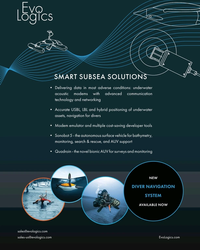 )
March 2024 - Marine Technology Reporter page: 2nd Cover
)
March 2024 - Marine Technology Reporter page: 2nd CoverSMART SUBSEA SOLUTIONS • Delivering data in most adverse conditions: underwater acoustic modems with advanced communication technology and networking • Accurate USBL, LBL and hybrid positioning of underwater assets, navigation for divers • Modem emulator and multiple cost-saving developer tools • Sonobot
-
 )
April 2024 - Maritime Reporter and Engineering News page: 43
)
April 2024 - Maritime Reporter and Engineering News page: 43restraint on any haste to participation included a "Transition in er systems would include an outline reform CII until a better understanding Transportation" panel session covering of standards for secure data exchange, of the impact of changing vessel speeds how to reduce shipping’s carbon foot-
-
 )
April 2024 - Maritime Reporter and Engineering News page: 39
)
April 2024 - Maritime Reporter and Engineering News page: 39Tech Files Latest Products, Systems and Ship Designs “Wall Climbing Robot” Danish Pilot calls gets ClassNK Nod LEGO Model "A tribute build to a work life at sea" Image courtesy MOL, Sumitomo Heavy Industries lassNK granted its Innovation Endorse- Image courtesy Espen Andersen/DanPilot ment for
-
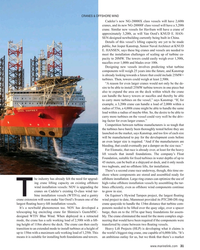 )
April 2024 - Maritime Reporter and Engineering News page: 31
)
April 2024 - Maritime Reporter and Engineering News page: 31CRANES & OFFSHORE WIND Cadeler’s new NG-20000X class vessels will have 2,600t cranes, and its new NG-20000F class vessel will have a 3,200t crane. Similar new vessels for Havfram will have a crane of approximately 3,200t, as will Van Oord’s KNUD E. HAN- SEN-designed newbuilding currently being built in
-
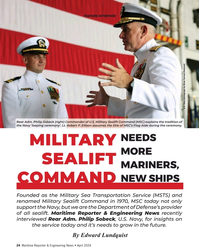 )
April 2024 - Maritime Reporter and Engineering News page: 24
)
April 2024 - Maritime Reporter and Engineering News page: 24assumes the title of MSC’s Flag Aide during the ceremony. NEEDS MILITARY MORE SEALIFT MARINERS, NEW SHIPS COMMAND Founded as the Military Sea Transportation Service (MSTS) and renamed Military Sealift Command in 1970, MSC today not only support the Navy, but we are the Department of Defense’s provider
-
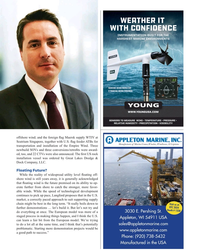 )
April 2024 - Maritime Reporter and Engineering News page: 23
)
April 2024 - Maritime Reporter and Engineering News page: 23offshore wind; and the foreign ? ag Maersk supply WTIV at Seatrium Singapore, together with U.S. ? ag feeder ATBs for transportation and installation of the Empire Wind. Three newbuild SOVs and three conversions/retro? ts were award- ed, too, and 22 CTVs were also announced. The ? rst US rock installa
-
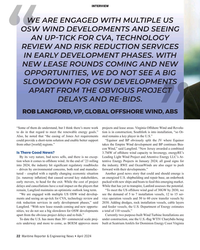 )
April 2024 - Maritime Reporter and Engineering News page: 22
)
April 2024 - Maritime Reporter and Engineering News page: 22INTERVIEW WE ARE ENGAGED WITH MULTIPLE US OSW WIND DEVELOPMENTS AND SEEING AN UP-TICK FOR CVA, TECHNOLOGY REVIEW AND RISK REDUCTION SERVICES IN EARLY DEVELOPMENT PHASES. WITH NEW LEASE ROUNDS COMING AND NEW OPPORTUNITIES, WE DO NOT SEE A BIG SLOWDOWN FOR OSW DEVELOPMENTS APART FROM THE OBVIOUS
-
 )
April 2024 - Maritime Reporter and Engineering News page: 18
)
April 2024 - Maritime Reporter and Engineering News page: 18MARKETS & gas activity returns, we anticipate that supply of the vessels The Question of Emissions to offshore wind projects will reduce, driving demand for ad- Given that SOVs and CSOVs operate in a segment target- ditional CSOVs. ing reduced emissions, and many operate in the North Eu- Outside of China
-
 )
April 2024 - Maritime Reporter and Engineering News page: 16
)
April 2024 - Maritime Reporter and Engineering News page: 16MARKETS SOVs – Analyzing Current, Future Demand Drivers By Philip Lewis, Director of Research, Intelatus © Björn Wylezich/AdobeStock t a high-level, there are three solutions to transferring Lower day rate CTVs are often used for daily transfer of technicians from shore bases to offshore wind farms
-
 )
April 2024 - Maritime Reporter and Engineering News page: 15
)
April 2024 - Maritime Reporter and Engineering News page: 15hydro-acoustic design of a propulsor that delays cavitation meets its underwater noise limits. This will require specialized inception and cavitating area. The third approach should be test sites or specialized mobile underwater testing equipment. isolation mounting of a vibro-active equipment and
-
 )
April 2024 - Maritime Reporter and Engineering News page: 13
)
April 2024 - Maritime Reporter and Engineering News page: 13from gasoline to methanol, but compared to just buying an EV After some pondering, I think I can reduce it to this logi- today that is a pointless exercise. It would actually make more cal sequence: sense to buy a plug-in hybrid that is con? gured for methanol It is the carbon. We want zero carbon as
-
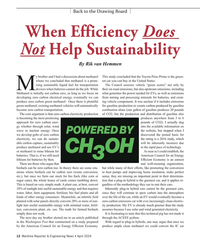 )
April 2024 - Maritime Reporter and Engineering News page: 12
)
April 2024 - Maritime Reporter and Engineering News page: 12Prius Prime is the green- where we concluded that methanol is a prom- est car you can buy in the United States. ising sustainable liquid fuel for transportation The Council assesses vehicle “green scores” not only by Mdevices when batteries cannot do the job. While their on-road emissions, but also upstream
-
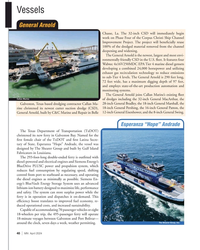 )
April 2024 - Marine News page: 40
)
April 2024 - Marine News page: 40, built by C&C Marine and Repair in Belle 12-inch General Eisenhower, and the 8-inch General Swing. Esperanza “Hope” Andrade The Texas Department of Transportation (TxDOT) christened its new ferry in Galveston Bay. Named for the ? rst female chair of the TxDOT and ? rst Latina Secre- tary of State, Esperanza
-
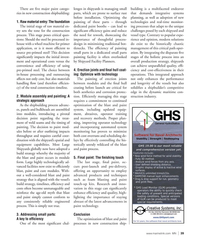 )
April 2024 - Marine News page: 39
)
April 2024 - Marine News page: 39There are ? ve major paint catego- lenges in shipyards is managing small building is a multifaceted endeavor ries in new construction shipbuilding: parts, which are prone to surface rust that demands integrative systems before installation. Optimizing the planning, as well as adoption of new 1.
-
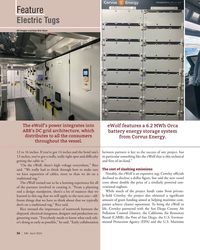 )
April 2024 - Marine News page: 34
)
April 2024 - Marine News page: 34Feature Electric Tugs All images courtesy Eric Haun The eWolf’s power integrates into eWolf features a 6.2 MWh Orca ABB’s DC grid architecture, which battery energy storage system distributes to all the consumers from Corvus Energy. throughout the vessel. 12 to 16 inches. If you’ve got 14 inches and
-
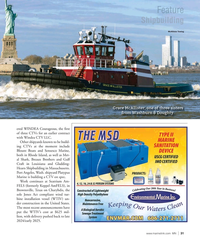 )
April 2024 - Marine News page: 31
)
April 2024 - Marine News page: 31McAllister Towing Grace McAllister, one of three sisters from Washburn & Doughty. ered WINDEA Courageous, the ? rst of three CTVs for an earlier contract with Windea CTV LLC. Other shipyards known to be build- ing CTVs at the moment include Blount Boats and Sensesco Marine, both in Rhode Island
-
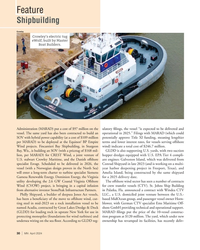 )
April 2024 - Marine News page: 30
)
April 2024 - Marine News page: 30Feature Shipbuilding Crowley Crowley’s electric tug eWolf, built by Master Boat Builders. Administration (MARAD) put a cost of $97 million on the ulatory ? lings, the vessel “is expected to be delivered and vessel. The same yard has also been contracted to build an operational in 2025.” Filings with
-
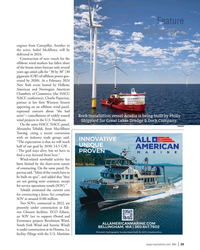 )
April 2024 - Marine News page: 29
)
April 2024 - Marine News page: 29engines from Caterpillar. Another in the series, Isabel McAllister, will be delivered in 2024. Construction of new vessels for the offshore wind markets has fallen short of the boom times forecast only several years ago amid calls for “30 by 30” (30 gigawatts (GW) of offshore power gen- erated by
-
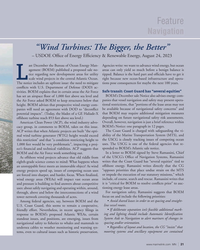 )
April 2024 - Marine News page: 21
)
April 2024 - Marine News page: 21the vi- ACP writes that when Atlantic projects are built “the opti- mal wind turbine generator (WTG) height would exceed ability of the Marine Transportation System (MTS), and this restriction” and that “a condition restricting height to the USCG is closely tracking issues of competing ocean uses
